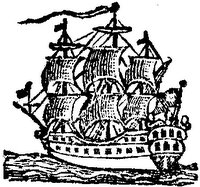New Books on the Early Supreme Court
Recently the New York Times reported on the upcoming final volume of the Documentary History of the Supreme Court of the United States, 1789-1800. Only thirty years ago, the Supreme Court Historical Society conceived of collecting all the disparate sources on the court's first years. The eighth and last volume has now gone to press.
We think of court records as being very complete, but that tradition was just becoming established in the eighteenth century. Josiah Quincy, Jr., took notes on major Massachusetts court cases in the 1760s as part of his own study and to share with colleagues, not as an official record. There's a nearly complete transcript of the trial of soldiers for the Boston Massacre in 1770, but only because a Loyalist printer saw value in it. No one knows the exact date of the Massachusetts Superior Court's ruling in 1783 that slavery was unconstitutional in the state because that isn't part of the legal filings.
The U.S. Supreme Court started out operating on similar rules, this article says. The justices didn't even ask lawyers to submit written arguments at first; after they made that request, it's unclear whether all attorneys complied, or whether the justices simply didn't save all the filings, because many are still missing. An entrepreneurial lawyer started publishing notes on the early sessions, but got at least one decision completely wrong. And in 1814 the British army burned the U.S. Capitol, which housed the court, and that didn’t do its official records any good.
Some curiosities from the Times article:
Justice David H. Souter, who cited “Suits Against States,” the fifth volume, in opinions on the losing side of two federalism cases, is one of the project’s most enthusiastic boosters.So Justice Souter cited the early court’s thinking on lawsuits against states and lost the argument, while Justice Rehnquist, who more often insisted the legal system should follow the founders’ original intent, didn’t use these records, went well beyond the language of the Eleventh Amendment, and won. Hmmmm.
“It’s not just a collection of documents,” Justice Souter said in an interview this month. “It gives us a broader contextual basis for understanding those early cases.”
When the project got under way in 1977, few would have supposed that some of the court’s earliest cases would gain new relevance. The court began to approach constitutional interpretation with a new interest in the founding generation’s original understanding.
For example, the 11th Amendment, which limits the jurisdiction of the federal courts to hear suits against states, became a hot topic during the 1990s when Chief Justice William H. Rehnquist, to Justice Souter’s dismay, dusted it off and invoked it as a bulwark of state sovereignty. The 11th Amendment was adopted to overturn a 1793 Supreme Court decision, and the history project’s fifth volume offers a font of information about that case, Chisholm v. Georgia, and about debates that have not been resolved to this day.
“It never pays to write off an amendment,” Justice Souter said dryly.
And then there's this tidbit about another book on the court:
While reading letters and diaries, Natalie Wexler, one of the associate editors, became captivated by the relationships among four of the original Supreme Court personalities—Justice James Wilson and his wife, Hannah, whom he married when he was 51 and she was 19; and Justice James Iredell and his wife, also named Hannah.Ms. Wexler’s novel, A More Obedient Wife, is available as a free download through Lulu.com.
“I feel I truly know them,” Ms. Wexler wrote in an essay in the Summer 2006 issue of The American Scholar, the magazine of the Phi Beta Kappa Society. “But of course,” she added, “what I know is largely what I’ve made of them. They’ve become ghostly emanations, hovering in some limbo between truth and fiction.”
Ms. Wexler, who also has written a historical novel about the Wilsons and the Iredells, imagines illicit passions that would raise plenty of eyebrows around the court today.



